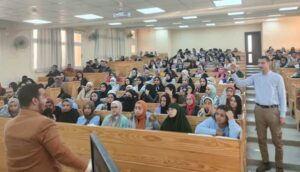ERU Faculty of Al-Alsun Discusses "Oral Translation Skills”... Photos
Dr. Makarem Al-Ghamry, Dean of the Faculty of Al-Alsun and Technical Languages at the Egyptian Russian University, announced that the faculty administration organized a seminar entitled “Oral Translation,” with the participation of the “English Language Department.” This falls within the framework of introducing the types of translations and the skills required for translators, categorized into “written translation, Oral Translation, and consecutive translation.” She emphasized that this aligns with the university’s strategy in organizing “seminars, workshops, training and practical visits, and educational trips” to develop students’ academic and personal skills, preparing them for the job market under the guidance of Dr. Sherif Fakhry Mohamed Abdel Nabi, the university president.
The Dean of the Faculty of Al-Alsun and Technical Languages pointed out that the lecture was delivered by Dr. Mohamed Amer, a translator at the Ministry of Foreign Affairs. He highlighted the essential skills needed for language learners and translators in the field of “Interpretation,” which are: “Listening & Speaking.” He clarified the difference between written translation and various forms of simultaneous interpretation. He explained to the audience that the simultaneous interpretation is one of the most challenging types of translation, and the four essential language skills are: “Listening, Speaking, Reading, and Writing.” He introduced whispered interpretation, remote interpreting through video, which is a newly introduced type in Egypt, and can reduce translation costs by nearly half. He further explained consecutive interpreting and telephone interpreting, used by communication companies like Vodafone UK and Vodafone Deutschland, and Concentrix for foreign residents in Arab regions like Egypt, for instance. In this type, the interpreter acts as a mediator between the customer service representative of the concerned company and the “foreign” caller, translating the complaint from the caller, conveying it to the customer service representative, translating the resolution from the representative, and conveying it to the caller. He also discussed relay interpreting, a form of translation used when the client seeks to reduce translation costs.
Moreover, Dr. Mohamed Amer, the lecturer, and interpreter at the Ministry of Foreign Affairs, stated that the simultaneous interpreter should possess the following skills:
- He/she should be proficient in both the source and target languages, possessing a vast vocabulary in both.
- The simultaneous interpreter must exhibit boldness, courage, and extensive cultural knowledge enabling him/her to handle challenging linguistic situations requiring decisive action in interpreting diverse texts in specializations.
- General culture contributes to shaping the interpreter’s awareness, which reflects positively on the interpreted product.
- Listening and remembering: Ideally, the simultaneous interpreter possesses some notes written hastily during speech, hence, there is a need for training to develop the listening skill, making attention to details difficult to forget. Therefore, they need to improve and maintain a strong memory.
- Presentation skills: His/her confidence while speaking and possessing control will enhance the interpreted text, demonstrating it more professionally.
- Objectivity in work: The simultaneous interpreter should understand that their role is not to express their personal ideas but rather to convey others’ ideas in different languages.
Dr. Mohamed Amer added that the steps of training in simultaneous interpretation are as follows:
- “Listening Skill”: By focusing on training in listening and repeating behind the speaker simultaneously. For example: Listening to a “presidential speech” and precisely repeating what was said in the same manner and accent for 7 to 10 seconds.
- “Audience Addressing Skill”: Speaking too fast, too slowly, stuttering, or hesitating should be avoided by simultaneous interpreters. They should possess a clear and distinct voice in its layers to convey the message smoothly. Simultaneous interpretation should be given special attention, along with the stance, expressive gestures, and facial expressions changes. Additionally, the use of hands helps strengthen simultaneous interpretation skills and different types of interpretation in general.
- Using some mobile applications.
- “Note-taking Skill”: One of the essential skills that a simultaneous interpreter must possess, aiding in enhancing simultaneous interpretation skills, is to rush to jot down notes as soon as one of the parties speaks. Hence, they need to carry a suitable-sized notebook that enables easy information review.
- Creating a list that includes all linguistic vocabulary in front of them.
At the end of the seminar, students posed inquiries and questions, expressing their utmost benefit from the distinctive content and discussions of the seminar.


